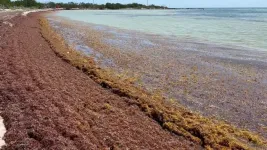One of the worst invasions of Sargassum in recent history, especially for Florida, occurred in 2022 and potential impacts this year are yet to be determined. Decomposing Sargassum produces hydrogen sulfide and ammonia, which can result in potential human and environmental health impacts. Once Sargassum deluges beaches, removing, disposing and repurposing the seaweed presents many logistical and economic challenges. Problems arise when Sargassum isn’t cleaned up in a timely manner.
However, cleaning up these huge piles of annoying seaweed that accumulate on the shores of Florida, the Gulf of Mexico and the Caribbean islands every year and protecting these critical habitats at the same time is a precarious struggle. As a major Florida attraction, maintaining clean and healthy beaches is imperative for the state’s tourist-based economy.
To address these challenges, researchers from Florida Atlantic University’s Harbor Branch Oceanographic Institute have received a $1.3 million grant from the Florida Department of Emergency Management for a project assessing the feasibility of in-water harvesting of this floating brown seaweed in Florida. Currently, in-water harvesting of Sargassum is not permitted due to its designation as Essential Fish Habitat (EFH) and critical habitat for sea turtles. Designation as EFH means it is considered a “substrate necessary to fish for spawning, breeding, feeding or growth to maturity.”
The FAU Harbor Branch project, “Mitigating Sargassum Inundation Impacts to Nearshore Waters and Beaches in Florida,” will examine both environmental and ecological impacts of Sargassum inundations in Florida.
“Sargassum is becoming a devasting mainstay in parts of Florida’s coastal communities, particularly in the Florida Keys, where massive blooms continue to recur,” said Brian Lapointe, Ph.D., principal investigator and a research professor at FAU Harbor Branch. “Economically, a ‘severe’ Sargassum event could have more than a $20 million impact in just the Keys alone. Environmentally, these blooms can potentially harm humans, exacerbate eutrophication, resulting in die-offs of seagrasses and corals, and kill recreational and commercially important species.”
For the project, Lapointe and his team will initially survey Sargassum inundation sites for fauna above the water using a drone, GoPro and other remotely operated vehicles, which also will enable them to quantify the size of the Sargassum mats. High-resolution aerial images of Sargassum inundation also will be collected from airplane flyovers to better measure the spatial extent of the impacts of Sargassum inundations.
Aerial images (drone, satellite) and on-the-ground morphometrics will be used to examine the changing physical structure of the beach (width, slope, sediment profile). The thickness of the Sargassum mat and biomass per square meter will be assessed in situ.
At first, a trial removal of Sargassum will be conducted using dip nets to test the viability of harvesting Sargassum without harming marine animals and other fauna under special permits for larger-scale removal from agencies such as the Florida Fish and Wildlife Commission and NOAA.
“After collection, we will scale up harvesting this seaweed using larger nets to remove biomass,” said Lapointe, one of the world’s foremost authorities on Sargassum and other harmful algal blooms. “During all sampling events, we will bring the biomass onboard our vessel and sort it to identify, quantify, measure and remove any fauna. The remaining Sargassum biomass will be retained for use by industry partners seeking sustainable, long-term solutions for repurposing this material.”
As the geographic extent and duration of blooms from the Great Atlantic Sargassum Belt increase, many jurisdictions have begun to explore novel uses for excess Sargassum biomass with the hope of turning it into economic opportunities such as biofuels and bioplastics. Because arsenic content may limit the use of Sargassum by industry partners, the FAU Harbor Branch researchers also will conduct in-depth studies of the mechanisms related to arsenic bioaccumulation in Sargassum on field-collected samples and in laboratory assays.
In addition, to better understand the impacts of Sargassum inundations on water quality, researchers will measure pH, dissolved oxygen, temperature, dissolved nutrients and fecal indicator bacteria in inundation sites.
Some fauna including small fish, shrimp and crabs, and samples of Sargassum tissue will be retained for stable isotope, heavy metal and tissue nutrient analyses. Researchers will assess the ecological effects of Sargassum beach harvesting by quantifying changes in population structure, abundance and chemical composition of common beach macroinvertebrates, such as amphipods, mole crabs, coquina clams and ghost crabs.
In addition, the change point where Sargassum ceases to provide EFH will be assessed with offshore to onshore transects. During these transects the mats will be assessed and the community composition and density of fauna will be compared by mat size and by distance to shore to assess if there is a density or distance from shore where the Sargassum mat represents a harmful algal bloom instead of functional habitat.
“Data from this timely research will help to inform managers whether it is better to harvest Sargassum in water as opposed to on the beach and help them better plan for removing vast amounts of seaweed from our beaches and preventing aggregations,” said James M. Sullivan, Ph.D., executive director, FAU Harbor Branch.
FAU Harbor Branch co-investigators of the project are Rachel Brewton, Ph.D., a research scientist; and Matt Ajemian, Ph.D., an associate research professor and director of the Fisheries Ecology and Conservation Lab.
- FAU -
About Harbor Branch Oceanographic Institute:
Founded in 1971, Harbor Branch Oceanographic Institute at Florida Atlantic University is a research community of marine scientists, engineers, educators, and other professionals focused on Ocean Science for a Better World. The institute drives innovation in ocean engineering, at-sea operations, drug discovery and biotechnology from the oceans, coastal ecology and conservation, marine mammal research and conservation, aquaculture, ocean observing systems and marine education. For more information, visit www.fau.edu/hboi.
About Florida Atlantic University:
Florida Atlantic University, established in 1961, officially opened its doors in 1964 as the fifth public university in Florida. Today, the University serves more than 30,000 undergraduate and graduate students across six campuses located along the southeast Florida coast. In recent years, the University has doubled its research expenditures and outpaced its peers in student achievement rates. Through the coexistence of access and excellence, FAU embodies an innovative model where traditional achievement gaps vanish. FAU is designated a Hispanic-serving institution, ranked as a top public university by U.S. News & World Report and a High Research Activity institution by the Carnegie Foundation for the Advancement of Teaching. For more information, visit www.fau.edu.
END




